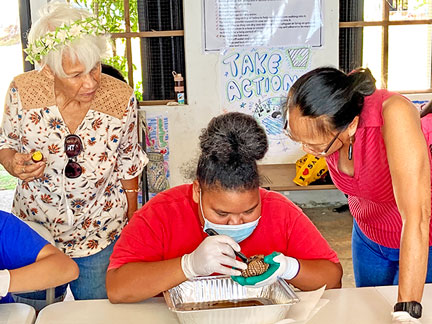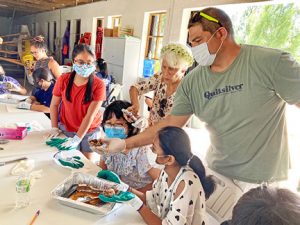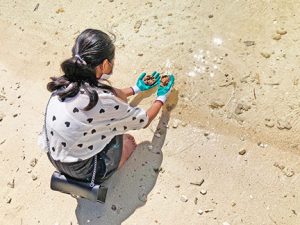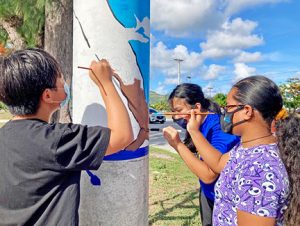FRIENDS OF THE MARIANA TRENCH’S PROJECT HOPE:
Building the CNMI’s future ocean conservationists

ChaCHa Ocean View Middle School student Anastacia Minor dissecting a sea urchin as Project HOPE ocean elders Chailang Palacios and Frances Sablan look on. (Iva Maurin)
While waiting for her group to begin painting the pole in front of Guma Sakman in Susupe, Anastacia Minor started sharing her insights on nature and its interconnectedness, the importance of taking care of our environment, and on what she thinks officials should do to ensure that even generations after her would have a place to call home.
Minor, from ChaCha Ocean View Middle School, is one of the 12 students participating in this year’s Project HOPE (Healthy Oceans and People Empowerment) a no-cost ocean science program of the Friends of the Mariana Trench, aimed at cultivating 30 new indigenous ocean/marine scientists by 2030.
“When you take away one thing, you’re not just taking away something, you’re taking away the whole. The whole thing is going to fall apart like a puzzle. That’s why it’s really important to keep [our environment] clean, to help it so it can grow more, so that the next generation can also expand, travel, and tell people about how [home] is like,” she added.
Minor particularly stressed how important it is to take care of the ocean given its “trauma” from ships and oil spills, and from people throwing trash. She appealed to officials to “work on people who are not taking care” of the environment, those who are harming home.

David Benavente of the Micronesia Islands Nature Alliance shows the student participants of Project HOPE how to dissect a sea urchin last Monday, June 7, at Guma Sakman in Susupe. (Iva Maurin)
“Show them what they’re doing to our environment because if they don’t, they’re just [going to] keep going and going. The environment, it’s getting destroyed all over by the people who are not taking care of our environment.”
Saipan Tribune went to observe Project HOPE’s session last Monday, June 7, where Minor with other students, were learning about sea urchins from David Benavente of the Micronesia Islands Nature Alliance. At the session, ocean elder Frances Sablan also shared her knowledge on how sea urchins were traditionally used for chunking by the islands’ fishermen.
Project HOPE marries scientific with cultural knowledge, through experiential learning, where students get to know about the oceans, climate change, coral reef life, marine protected areas, mangrove trees, currents and tides, among many others.
Our ocean is threatened
To spread awareness on ocean conservation, the students helped paint two Project Haligi poles nearest Guma Sakman, under the guidance of Project HOPE’s interns, who are members of the Northern Marianas College’s Environment and Natural Resources Organization.
One pole was painted with endangered/threatened ocean species in the CNMI, and the other, painted with food fishes on island. Tina Marie Kaneshi, also a student of ChaCha Ocean View, got assigned to paint the latter.

Student cleaning off a sea urchin dissected during a Project HOPE presentation from the Micronesia Islands Nature Alliance. 9Iva Maurin)
Kaneshi shared with Saipan Tribune her frustrations whenever she would see other children littering in the ocean. “How many times I’ve seen a kid litter in the ocean and just leave their trash there. It disgusts me. You should pick up your trash. It sucks to just see all the candy wrappers and favors from fiestas in there. They just leave the trash in there and I hate that.”
“The environment and the ocean… it’s an important thing. It supports most life here, supports the economy as well. Its health has been declining more and more, and if it just keeps declining, it’s going to die out and all that past knowledge, all that’s in there – all the fish, all the jobs that are about the ocean, it’s going to go down,” she added.
Rochelle Ramon, one of Project HOPE’s interns, spearheaded the painting project so the students can help spread ocean conservation awareness, stressing the importance of the ocean to the community, in terms of coastal protection, food, even to the oxygen that we all breathe.
“We focus on ocean conservation. It is an important project we can move forward with, especially with the kids, just to have them learn more and become more ocean conservative too, right now and in the future, as they’re our future generations.”
‘The best of both worlds’
Through Project HOPE, the students get scientific information from environmental experts, and life and cultural knowledge from ocean elders.

Project HOPE student participants paint endangered/threatened ocean species on a Project Haligi pole near Guma Sakman in Susupe to increase ocean conservation awareness in the community. (Iva Maurin)
For ocean elder Frances Sablan, the youth get the best of both worlds through Project HOPE. The students do not just know about the theories and the scientific, but they also get to know the culture, which makes ocean learning more relatable and relevant to them and their lives.
“If we don’t impart to them the knowledge and the values, then they will not protect [our environment], they won’t conserve, they will just treat it as if it is unimportant. So, by teaching them, hopefully they would realize the value, and why they need to be the protectors and the conservationists,” Sablan said.
“I can relate back when I was their age, by going out and helping clean the environment, by collecting bottles or trash along the road, it made me a firm believer that I need to help clean my environment. And I get upset with anyone who trashes it because I experienced a hardship.”
Sablan added that this is the kind of sentiment that she wants to pass on to the youth, to have them realize that by being participatory on how to take care of and be stewards of the land and the ocean, that they really would be active participants, and active movers and shakers.
Hopwood Middle School’s Jose Iguel, also a Project HOPE participant, echoes this. For Iguel, what the P
roject is doing is important, stating that “if you learn when you’re young, when you get older, that information becomes useful.”
What is being learned by the students through Project HOPE could also prove useful to everyone else in the community, and for Sablan, this is particularly true to those who trash, do negative things, and have a carefree attitude on the island.
“They need to also join in,” Sablan said. “They also need to be part of the process, because they’re the ones that really need to take home the knowledge and the wisdom, and the values. It is important… There is hope. There’s a lot of factors that will pull us down in the environment but with this [Project HOPE], and with others that also support the idea and concept, there is [hope].”
To learn more about Project HOPE, and other programs of the Friends of the Mariana Trench, call (670) 483-FOMT (3668), or email info@friendsmarianatrench.org.



























